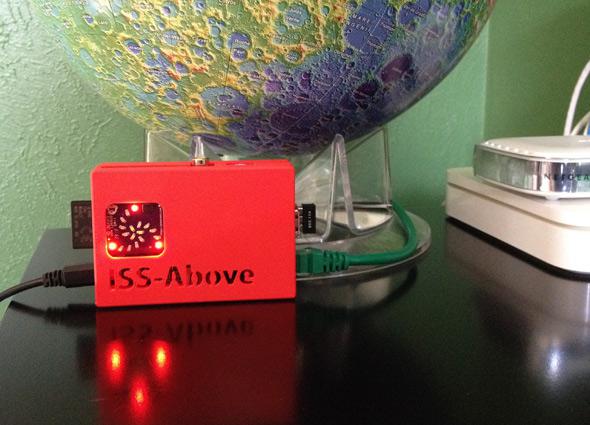Even with me flailing my arms and telling people all about it a lot, there are still some folks who don’t know that you can see satellites orbiting over your head. Even though many are small and hundreds of kilometers away, they reflect sunlight and can be easily seen from even moderately dark sites.
But the International Space Station is an exception … in that you don’t need a dark site. Its big solar panels and 100-meter length mean that during a good pass, it can outshine Venus!
Its orbit is well-understood, which means such passes are predictable. And that’s the key to a clever little device called ISS-Above, created by programmer Liam Kennedy.
ISS-Above connects to the Internet and, using your position and time, calculates the orbit of the station and finds the next time the ISS will be visible from your location. (It has a Raspberry Pi board inside.) Different versions display the info in different ways; one actually displays the date and time of the next pass, another has a scrolling display (like a banner), and yet another has a panel (called a PiGlow) that has a spiral pattern of bright colored LEDs, coded by color to let you know how long it is to the next ISS pass. It goes nuts and flashes all the colors when the station is actually above you (I’ll note it does this for daytime passes, when the bright sky makes seeing the ISS essentially impossible … but it’s still fun to know it’s overhead). It’ll also tweet out a message when the ISS is visible and more than 30° above the horizon.

Photo by Phil Plait
Setting it up is easy; you just connect it via an Ethernet cable and plug it in. When you order it, Kennedy sets it for your location, so you should be good to go. I tested it against the predictions of Heavens-Above, and it worked quite well. If you have a bit of tech know-how, more options are available; it can serve up a Web page you can access with more info about ISS passes (like dates, times, and brightnesses), you can connect to it via Wi-Fi, and you can change the way it tweets, too. More info about all that, and the different ISS-Above versions you can get, are available at Kennedy’s website.
Kennedy was on This Week in Tech to talk about the device and how he created it:
I’ll admit it’s kinda fun to see it flashing more and more as the time of an overhead pass nears. I expect individual people would love it, but I suspect it would really find a great home in classrooms, where it can sit in a highly-visible place where students can all see it. It might be a bit distracting, but the payoff is a better appreciation for what’s going on above their heads, and that’s a pretty good result. Of course, in general during school hours it’s usually daytime, but if they access the device’s website while at school they can find out if there will be a good pass that night, and then go to other sites like Heavens-Above to get more info. Win-win.
Kennedy had a Kickstarter to initially (and very successfully) fund ISS-Above, but he can still take orders for it up until the end of next week, so if you want one, better order before April 4! After that you’ll be out of luck.
Full disclosure: Liam sent me a unit to test out, and it’s sitting on my desk now. But I quite like it; even though I try to see ISS whenever I can, it slips my mind when I’m working. I think the bright lights on the device will do a great job reminding me when I’m otherwise distracted. So my thanks to Liam for the unit, and I do hope he gets lots more orders.
